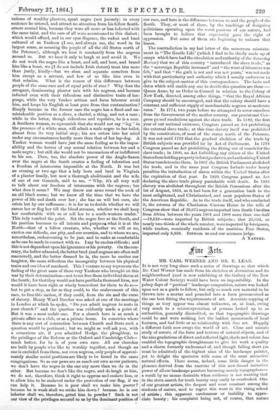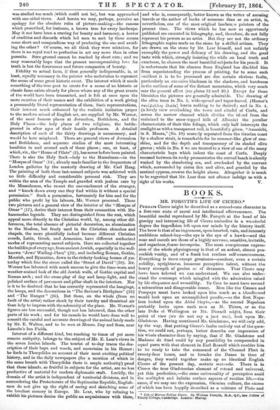Ime arts.
MR. CARL WERNER AND MR. E. LEAR.
IT is not very long since such a series of drawings as that which Mr. Carl Werner has made from his sketches at Jerusalem and its neighbourhood (and is now exhibiting at the Gallery of the New Water Colour Society) would have been an impossibility. In the palmy days of " poetical" landscape composition, nature was looked upon not as a guide to follow, but only so much raw material to be thrown into a mortar and pounded into a form preconceived as the one best fitting the requirements of art. Accurate copying of things as they appear was almost unknown, or, at least, owing very much to a misinterpretation of persons looked up to as authorities, generally discredited, so that topographic drawings could be and were nothing but the baldest memoranda of local features, and had little or no relationship with fine art. Happily a different faith now sways the world of art. Close and minute study of nature, of the form and texture of natural objects, and of the nice gradations of direct and reflected light, shade and colour, has enabled the topographic draughtsman to give his work a quality and a charm formerly undreamed of, and though falling short (as must be admitted) of the highest aims of the landscape painter, yet to delight the spectator with some of the most attractive natural effects. There seems, indeed, some little danger in the pleasure derived from the exercise of this new-found imitative power of all our landscape painters becoming merely topographers— a result by no means desirable when evidence is not wanting that in the stern search for truth beauty may easily be overlooked. One of our greatest artists, the deepest and most constant among the students of nature, used to regret this want in the rising school of artists ; this apparent carelessness or inability to appre- ciate beauty ; his complaint being not, of course, that nature
was studied too much (which could not be), but was approached with one-sided views. And herein we may, perhaps, perceive an apology for the obsolete rules of picture-making—the canons which prescribed, for instance, a brown tree for every landscape. May it not have been a craving for beauty and harmony, a horror of crudities and discords which led men to seek by these means some short and compendious way of producing the one and avoid- ing the other? Of course, we all think they were mistaken, for there is no royal road to perfection in art any more than in other pursuits. Sure ground cannot be reached by short cuts ; and we may reasonably hope that the present uncompromising love for truth is but the forerunner and future companion of beauty.
Fidelity to actual facts, if thus generally indispensable, is, at least, equally necessary in the painter who undertakes to represent the scene of some great historic event. The interest which it needs something of the true poet to create for a scene of no historic or classic fame exists already for places where any of the great events
of the world have been transacted, and is felt at once upon the mere mention of their names and the exhibition of a work giving a presumably literal representation of them. Such representations, their interest much enhanced by the realistic imitation proper to the modern school of English art, are supplied by Mr. Werner, of the most famous places at Jerusalem, Bethlehem, and the Holy Places—the holy places of two religions, the battle- ground in after ages of their hostile professors. A detailed description of each of the thirty drawings is unnecessary, and would be here misplaced. There are general views of Jerusalem and Bethlehem, and separate studies of the most interesting localities in and around each of those places ; one, at least, of which, viz., the "House of Pilate" (2), has never before been painted. There is also the Holy Rock--holy to the Mussulman—in the "Mosque of Omar' (14), already made familiar to the frequenters of London galleries by the masterly drawing of Mr. Carl Haag. The painting of both these last-named subjects was achieved with no little difficulty and considerable personal risk. They are within the area of the Temple and guarded with jealous care by the Mussulmans, who resent the encroachment of the stranger, and " knock down every one they find within it without a special permission." Such a permission, fortunately for him and for the public who profit by his labours, Mr. Werner procured. These two pictures and a general view of the interior of the "Mosque of Omar" (17), derive their interest from their connection with Mo- hammedan legends. They are distinguished from the rest, which appeal more directly to the Christian world, by, among other dif- ferences, the total absence of pictorial decoration, an abomination to the Moslem, but freely used in the Christian churches and chapels, the more plentifully indeed because different Christian creeds, Latin, Greek, and Armenian, have different authorized modes of representing sacred subjects. Here are collected together the buildings of every age, from ancient Jewish, especially in the well- known "Jews' Wailing-Place" (22), and including Roman, Gothic, Moorish, and Byzantine, down to the rickety-looking houses of yes- terday which line the street called the "Street of David" (28). Mr. Werner has laboured with much success to give the time-worn and weather-stained look of the old Jewish walls, of Gothic capital and Roman arch ; and the cross-play of day and lamp-light, and the polished surface of pavement and pillar-shaft in the interiors. Nor is it to be doubted -that he has correctly represented the hangings, the lamps, and the decorations in "The Saviour's Birthplace" (24) and "The Manger" (25). But these, on the whole (from no fault of the artist) rather shock by their tawdry and theatrical air than help to impress with the solemnity of the place. Mr. Werner's figures are less successful, though not less laboured, than the other parts of his work ; and for his camels he would have done well to consult the careful and accurate drawings of the animal lately made by Mr. E. Walton, and to be seen at Messrs. Day and Sons, near Lincoln's Inn Fields.
Interest of a different kind, but reaching to times of yet more remote antiquity, belongs to the subject of Mr. E. Lear's views in the seven Ionian Islands. The tourist of to-day traces the des- cription of their bays, and woods, and mountains in his Homer; he finds in Thucydides an account of their most exciting political history, and in the daily newspapers (for a mention of which in the same breath with Thucydides there is ample authority) proof that these islands, so fruitful in subjects for the artist, are no less productive of material for modern diplomatic craft. Luckily, the domain of the artist is independent of territorial divisions, and in surrendering the Protectorate of the Septinsular Republic, English- men do not give up the right of seeing and sketching some of the loveliest scenery in Europe. Mr. Lear, who by refusing to exhibit his pictures denies the public an acquaintance with them,
and who is, consequently, better known as the writer of amusing travels or the author of books of nonsense than as an artist, is, nevertheless, one of the most original landscape painters of the present time. The views which he has now so opportunely published are executed in lithography, and, therefore, do not fully represent his powers as an artist. But they are not the ordinary lithographic copies made on the stone by a skilled artizan. They are drawn on the stone by Mr. Lear himself, and not unfairly exemplify the power and delicacy of his drawing, and the good taste with which, strongly insisting the while on local truth and exactness, he chooses the most beautiful subjects for his pencil. It is unfortunate that his absence from England has disabled him from superintending the process of printing, for to some such accident it is to be presumed are due certain obvious faults, particularly an excessive blackness in the shadows, and harshness in the outlines of some of the distant mountains, which very much mar the general effect (see plates 12 and 20.) Except for these blemishes the pictures are generally admirable. The drawing of the olive trees in No. 5, wide-spread and taper-leaved, (Homer's rarLypeX).og iXaia) leaves nothing to be desired ; and in No. 4, (a lovely view overlooking the town and citadel of Corfu, and across the narrow channel which divides the island from the mainland to the snow-topped hills of Albania) the peculiar characteristic of their thin foliage, which only half intercepts the sunlight as with a transparent veil, is beautifully given. "Amaxichi, in S. Maura," (No. 10) scarcely separated from the Grecian coast by a shallow strait, is remarkable for its summer-like glow of sun- shine, and for the depth and transparency of its shaded olive groves ; while in No. 6 we are treated to a view of one of the many characteristic bays which indent the coast of Corfu. Deeply recessed between its rocky promontories the curved beach is silently washed by the slumbering sea, and overlooked by the convent which, surrounded by cistus ilex and olive, and guarded by the sentinel cypress, crowns the height above. Altogether it is much to be regretted that Mr. Lear does not oftener indulge us with a































 Previous page
Previous page